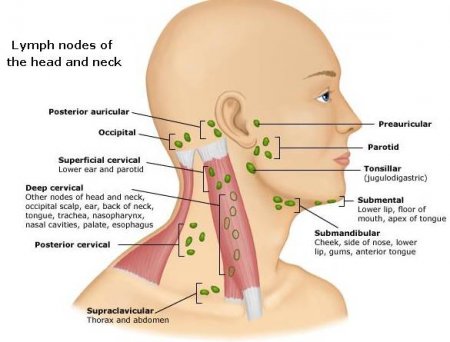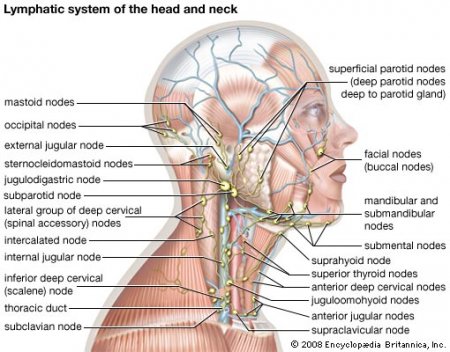The lingual tonsils
- Category: Immune and lymphatic systems
- Views: 82040
The lingual tonsil is a small mound of lymphatic tissue located at the back of the base of the tongue. Two lingual tonsils are in the mouth, one on each side of the tongue. They are composed of lymphatic tissue that functions to assist the immune system in the production of antibodies in response to invading bacteria or viruses. If the tonsils are repeatedly swollen or infected over an extended period of time, they may need to be removed.
The cervical nodes
- Category: Immune and lymphatic systems
- Views: 80957
The cervical nodes are one of the six major locations of lymph nodes. They are grouped along the lower border of the jaw, in front of and behind the ears, and deep in the neck along the larger blood vessels. They drain the skin of the scalp, face, tissues of the nasal cavity, and the pharynx. All lymph nodes have the primary function of the production of lymphocytes, which help defend the body against microorganisms and against harmful foreign particles and debris from lymph before it is returned to the blood stream.
The adenoids (the pharyngeal tonsils)
- Category: Immune and lymphatic systems
- Views: 83157
The adenoids, also known as the pharyngeal tonsils, are a part of the lymphatic system located in the back of the throat and up into the nasal cavity. Much like the tonsils (palatine tonsils), the adenoids are made up of folded lymphatic tissue, lined with epithelial cells, house mucosal glands, and are covered in cilia and mucus. One single such fold is termed an adenoid.
The immune and lymphatic system of the head and neck
- Category: Immune and lymphatic systems
- Views: 85422
The immune and lymphatic system of the head and neck includes the tonsils, several sets of lymph nodes, countless lymphatic vessels, and red bone marrow. All of these structures work together to drain, filter and cleanse the interstitial fluids of the head and neck and destroy harmful pathogens that may infect this region.
The thymus gland
- Category: Endocrine system, Immune and lymphatic systems
- Views: 166268
The thymus gland, despite containing glandular tissue and producing several hormones, is much more closely associated with the immune system than with the endocrine system. The thymus serves a vital role in the training and development of T-lymphocytes or T cells, an extremely important type of white blood cell. T cells defend the body from potentially deadly pathogens such as bacteria, viruses, and fungi.
The thymus is a soft, roughly triangular organ located in the mediastinum of the thoracic cavity anterior and superior to the heart and posterior to the sternum. It has two distinct but identical lobes that are each surrounded by a tough, fibrous capsule. Within each lobe is a superficial region of tissue called the cortex and a histologically distinct deep region called the medulla. Epithelial tissues and lymphatic tissues containing dendritic cells and macrophages make up the majority of both regions of the thymus.
The spleen
- Category: Digestive system, Immune and lymphatic systems
- Views: 156780
The spleen is a brown, flat, oval-shaped lymphatic organ that filters and stores blood to protect the body from infections and blood loss.
Protected by our ribs, the spleen is located between the stomach and the diaphragm in the left hypochondriac region of the abdominal body cavity. The splenic artery branches off from the aorta and the celiac trunk to deliver oxygenated blood to the spleen, while the splenic vein carries deoxygenated blood away from the spleen to the hepatic portal vein. A tough connective tissue capsule surrounds the soft inner tissue of the spleen.





